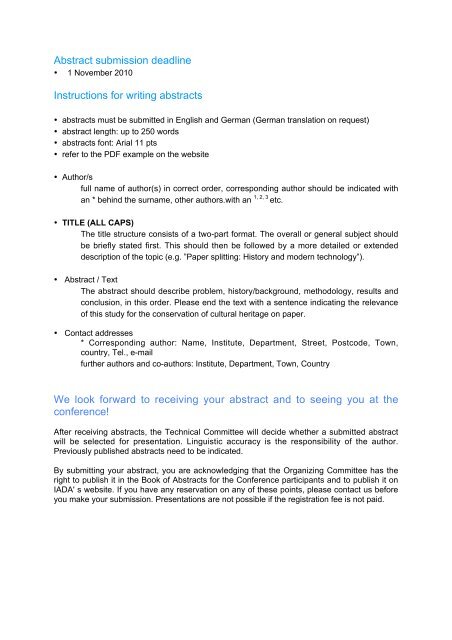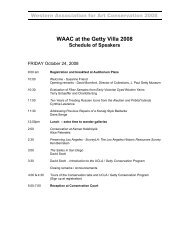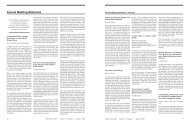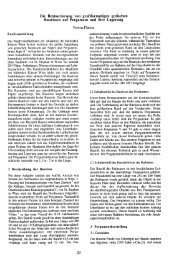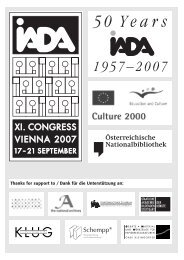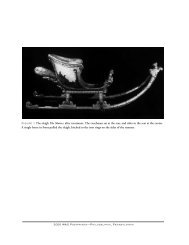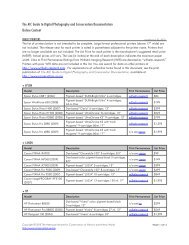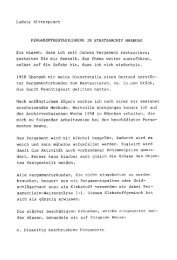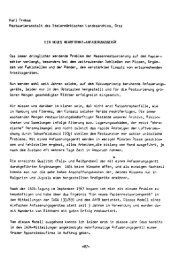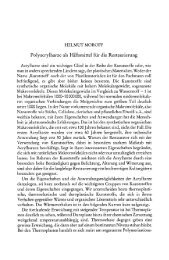Abstract submission deadline Instructions for writing abstracts We ...
Abstract submission deadline Instructions for writing abstracts We ...
Abstract submission deadline Instructions for writing abstracts We ...
You also want an ePaper? Increase the reach of your titles
YUMPU automatically turns print PDFs into web optimized ePapers that Google loves.
<strong>Abstract</strong> <strong>submission</strong> <strong>deadline</strong><br />
• 1 November 2010<br />
<strong>Instructions</strong> <strong>for</strong> <strong>writing</strong> <strong>abstracts</strong><br />
• <strong>abstracts</strong> must be submitted in English and German (German translation on request)<br />
• abstract length: up to 250 words<br />
• <strong>abstracts</strong> font: Arial 11 pts<br />
• refer to the PDF example on the website<br />
• Author/s<br />
full name of author(s) in correct order, corresponding author should be indicated with<br />
an * behind the surname, other authors.with an 1, 2, 3 etc.<br />
• TITLE (ALL CAPS)<br />
The title structure consists of a two-part <strong>for</strong>mat. The overall or general subject should<br />
be briefly stated first. This should then be followed by a more detailed or extended<br />
description of the topic (e.g. ”Paper splitting: History and modern technology”).<br />
• <strong>Abstract</strong> / Text<br />
The abstract should describe problem, history/background, methodology, results and<br />
conclusion, in this order. Please end the text with a sentence indicating the relevance<br />
of this study <strong>for</strong> the conservation of cultural heritage on paper.<br />
• Contact addresses<br />
* Corresponding author: Name, Institute, Department, Street, Postcode, Town,<br />
country, Tel., e-mail<br />
further authors and co-authors: Institute, Department, Town, Country<br />
<strong>We</strong> look <strong>for</strong>ward to receiving your abstract and to seeing you at the<br />
conference!<br />
After receiving <strong>abstracts</strong>, the Technical Committee will decide whether a submitted abstract<br />
will be selected <strong>for</strong> presentation. Linguistic accuracy is the responsibility of the author.<br />
Previously published <strong>abstracts</strong> need to be indicated.<br />
By submitting your abstract, you are acknowledging that the Organizing Committee has the<br />
right to publish it in the Book of <strong>Abstract</strong>s <strong>for</strong> the Conference participants and to publish it on<br />
IADA' s website. If you have any reservation on any of these points, please contact us be<strong>for</strong>e<br />
you make your <strong>submission</strong>. Presentations are not possible if the registration fee is not paid.
Deadline zum Einreichen der Zusammenfassung:<br />
• 1. November 2010<br />
Anleitung zum Schreiben des <strong>Abstract</strong>s<br />
• <strong>Abstract</strong>s müssen in Englisch und Deutsch eingereicht werden<br />
• Laenge: 250 Worte maximal<br />
• <strong>Abstract</strong>s font: Arial 11 pts<br />
• Bitte schauen Sie auch das PDF Beispiel auf der IADA <strong>We</strong>bsite an<br />
• Autor/en<br />
Autor/en (bitte in der korrekten Reihenfolge), Kontakt-Autor bitte mit einem * hinter dem<br />
Namen kennzeichnen, weiter Autoren mit 1,2<br />
• Titel (fett, GROSSBUCHSTABEN)<br />
Für jeden Beitrag sollte eine aussagekräftige zweiteilige Überschrift (Haupt- und Untertitel)<br />
gewählt werden. Der erste Teil sollte das allgemeine Thema kurz zusammenfassen. Der<br />
Untertitel soll eine ausführlichere Beschreibung des Themas beinhalten (z.B.<br />
”Papierspaltung: Geschichte und moderne Technologie”)<br />
• <strong>Abstract</strong> / Text (Arial 11)<br />
Zusammenfassung soll das zu lösende Problem, den Hintergrund, Methoden, Ergebnisse<br />
und Schlussfolgerungen in dieser Reihenfolge beinhalten.<br />
• Kontaktadressen<br />
* Korrespondierender Autor: Name, Institut, Abteilung, Strasse, PLZ, Stadt, Land, Tel., email<br />
1, 2, 3 weitere Autoren und co-Autoren: Institut, Abteilung, Stadt, Land<br />
Wir freuen uns darauf, Ihren Beitrag zu erhalten und Sie auf unserer<br />
Konferenz begruessen zu dürfen!<br />
Nachdem die <strong>Abstract</strong>s eingetroffen sind, wird das Technische Komitee entscheiden, welche<br />
Beiträge zum Vortrag ausgewählt werden. Sprachliche Korrektheit liegt in der Verantwortung<br />
des/der Autoren. Beiträge die bereits publiziert wurden, müssen gekennzeichnet werden mit<br />
Angabe des Jahres und der Zeitschrift.<br />
<strong>We</strong>nn Sie ihren Beitrag einreichen, stimmen Sie zu, dass IADA diesen <strong>Abstract</strong> in den<br />
Konferenzunterlagen und auf der IADA <strong>We</strong>bsite publiziert. Sollten Sie hierzu Fragen oder<br />
Vorbehalte haben, nehmen Sie bitte Kontakt mit uns auf. Vorträge können nur gehalten<br />
werden, wenn der Konferenzbeitrag beglichen ist.
SIDE EFFECTS INDUCED BY THE USE OF SEVERAL IONIC FIXATIVES:<br />
COLOUR CHANGES THROUGH ARTIFICIAL AND NATURAL AGEING<br />
Marine Letouzey 1 *, Véronique Rouchon 2 , Maud Barbalat 2<br />
Anionic and cationic fixatives are extensively used in the conservation field. Their efficiency<br />
has been tested and reported in the literature but little in<strong>for</strong>mation is available on the longterm<br />
effects of their use.<br />
In this study, these effects were evaluated on three sample papers. Two are white and<br />
contain no additives. The third is light brown and made of a mixture of sulphite bleached<br />
mechanical pulp, sized with rosin and alum. Two anionic fixatives (Mesitol® NBS, Rewin®<br />
KBL) and two cationic fixatives (Sandofix®, Rewin® EL) were prepared in several<br />
concentrations ranging 1 to 10 %. A mixture of both kinds (available on the market) was also<br />
tested. Two fixation procedures, representing the approximate extremes of use, were<br />
chosen. In the first, the papers were impregnated with the fixatives and not washed. In the<br />
second, the papers were impregnated with the fixatives, washed, dried and then de-acidified<br />
in a calcium bicarbonate solution. Artificial and natural light ageing, as well as artificial<br />
climatic ageing were then carried out. Mechanical testing (0-span) showed no change after<br />
ageing. However significant fluorescence phenomena and colour changes occurred<br />
especially on the white papers. While the most important changes were observed on the<br />
white unwashed papers, significant changes also occurred on washed and de-acidified<br />
samples.<br />
Mesitol® NBS was by far the most reactive fixative. This work demonstrates that the use of<br />
ionic fixatives induces long term effects on the cellulose, even after a washing and deacidification<br />
treatment.<br />
*1 Marine Letouzey, 25 rue Campo Formio, 75013 Paris, France,<br />
Tel. +33-6-77810140, marine.letouzey@free.fr (corresponding author)<br />
2 Centre de Recherche pour la Conservation des Collections, MNHN-CNRS, Paris, France


